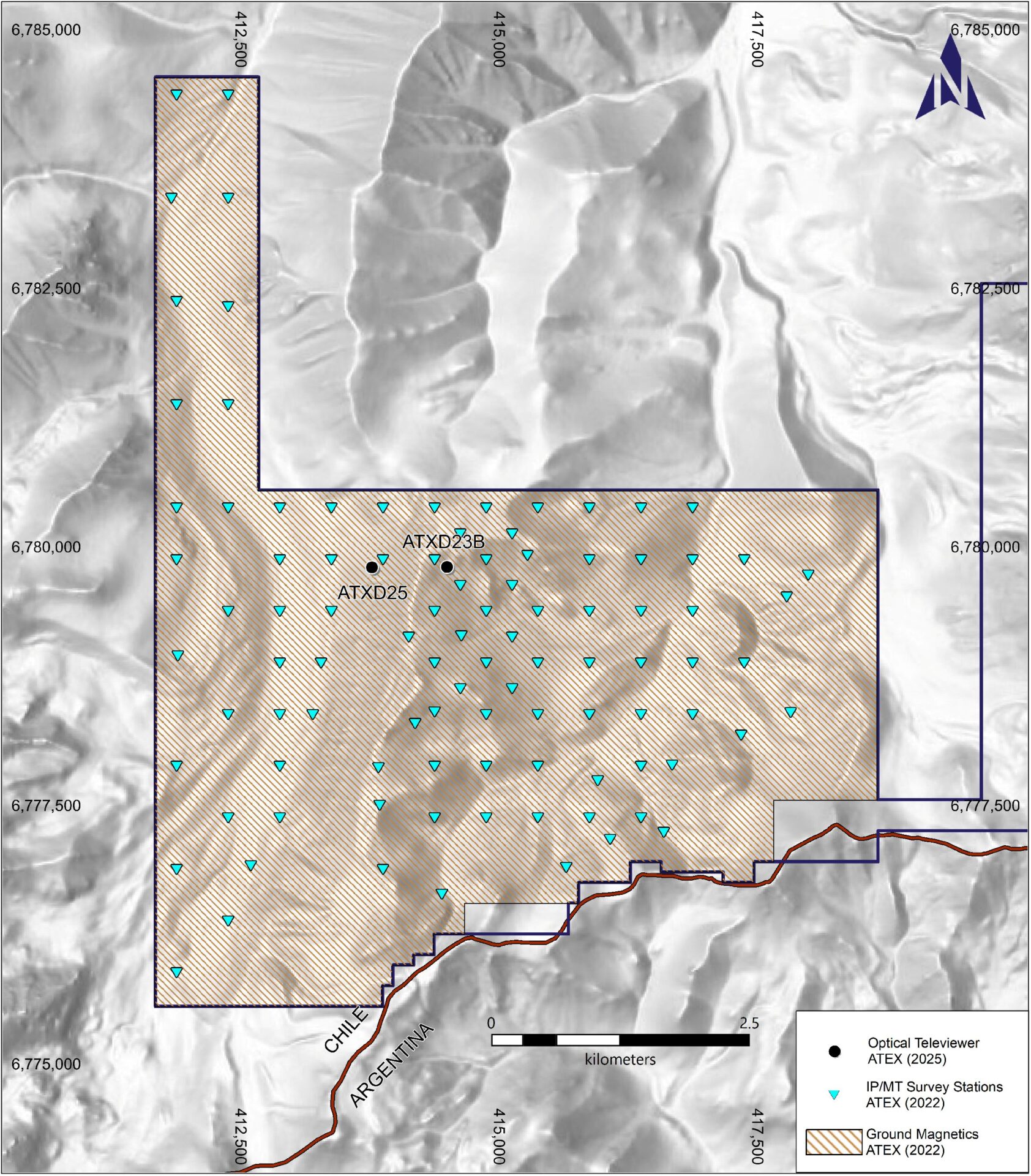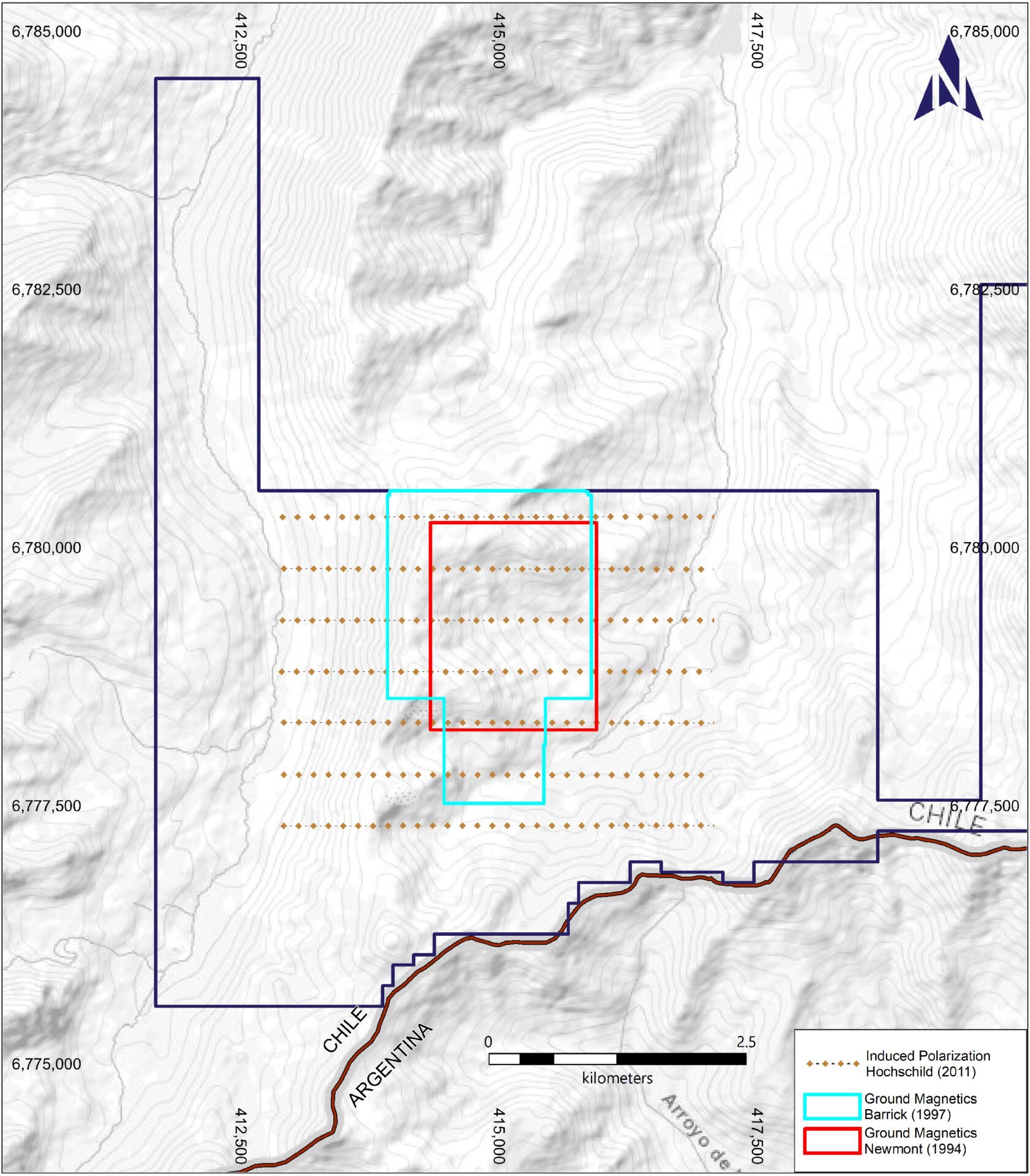In early 2022, ATEX completed a deep-penetrating magnetotelluric (“MT”) geophysical survey and a ground magnetic survey (“Mag”) over the entire Valeriano property (Figure 1). Both surveys were successful in establishing a clear association with previous surveys completed by third parties.
Figure 1: ATEX geophysical surveys coverage area
Modelling of the MT survey data down to 2,000 metres depth identified a zone of low resistivity, coincident with a subcircular chargeability and low-resistivity anomaly, three kilometres in diameter, outlined by a historical induced polarization (“IP”) survey that penetrated to a depth of 800 metres. The mineralization within the Valeriano Copper-Gold Deposit correlates well with the broad MT resistivity anomaly that extends significantly to depth and laterally, suggesting continuation of the porphyry mineralization in all directions (Figure 2).
Both the 2021 MT and 2022 ground magnetics data, and Hochschild IP data from 2011, was subsequently inverted and provided an anomalous conjunction of resistivity, induced polarization, and magnetic responses characteristic of a porphyry copper system. The inversions provided a clear 3D spatial orientation of the lower oxide boundary, upper porphyry boundary the openness of the porphyry target at depth. The inverted data sets were subsequently used for drill hole targeting for Phase III (2022-23) and are being used for Phase IV (2023-24) drill hole targeting.
High-grade corridors have been interpreted over the Magnetization Vector Inversion (MVI) image from the recent Mag survey. A western high-grade corridor concurs with the +1.0% CuEq zones of drill holes ATXD171 and VALDD13-0142. An untested eastern corridor is suggested by the magnetic survey, below the collar of drill hole VALDD13-0162, not cut by this hole. The corridors have a N-S to NNE strike coincident with general attitude of outcropping inter-mineral porphyries and mineralization at El Encierro.
Figure 2: Schematic sections of inverted IP and MT surveys relative to drilling
Pre-ATEX Geophysics
Hochschild completed 36 km of pole-dipole induced polarization geophysics in 2011 (Jordan, J. 2011) (Figure 3). This IP survey outlined a large chargeability zone measuring approximately two by three kilometres in size and down to a depth of four hundred metres. A strongly resistive zone overlies this chargeability anomaly (Argali, 2011).
In January and February of 1997, Barrick conducted a ground magnetic survey totalling 57.1line kilometres over the Valeriano Project (Figure 3).
Newmont completed a ground magnetic geophysical survey in January 1994 (Figure 3). A number of structural trends were mapped out from this work and magnetic low anomalies were noted as being potential areas of alteration. A zoned concentric mag high feature was reported and was believed to be representative of a deeper intrusive body.
Figure 3: Areas Covered by Geophysical Surveys Pre-ATEX
1 For ATXD-17 results, procedures and QA/QC information, see press release from June 13, 2022.
2 For further information, please see technical report titled “Independent Technical Report for the Valeriano Copper-Gold Project, Atacama Region, Chile” by Glen Cole, PGeo, David Machuca, PEng, and David Middleditch, ACSM, MIMMM with an effective date of September 23, 2025, filed at www.sedarplus.ca on November 3, 2025, for additional details n the 2025 Mineral Resource Estimate for the Valeriano project. As set out in the foregoing technical report, Copper Equivalent (CuEq) is calculated assuming US$3.80/lb Cu, US$2,750/oz Au, US$27/oz Ag, and US$22/lb Mo and metallurgical recoveries of 94% for Cu, 95% for Au, 80% for Ag, and 64% for Mo using the formula CuEq % = Cu % (10499.12432 * Au g/t /10000) + (82.424482 * Ag g/t /10000) + (3.5790963 *Mo g/t /10000).



